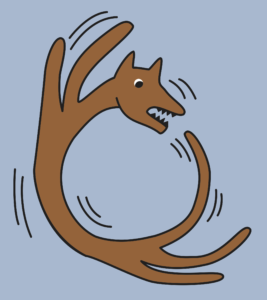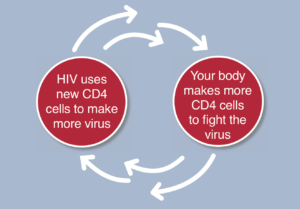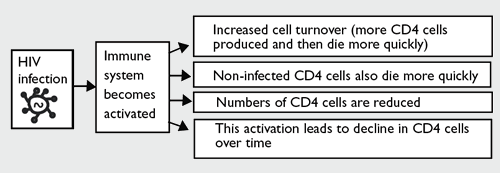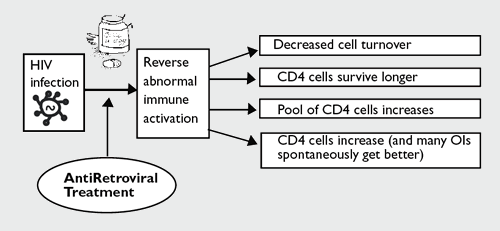
1. 6 How does HIV interact with the immune system?
 HIV is an especially difficult virus for the body to deal with.
HIV is an especially difficult virus for the body to deal with.
This is because HIV uses CD4 cells as factories to make more virus.
So the immune cells that the body usually uses to fight an infection are instead used by HIV to reproduce (replicate).
Together, when not on treatment, this is like a dog going round and round chasing its own tail.
- HIV causes your body to produce more CD4 cells to fight this new infection.
- These new cells provide more cells for HIV to infect and reproduce.
- The body responds by making even more cells to fight the new virus etc.
- This cycle continues every day and slowly, usually over many years, the immune system becomes worn out.
 Most people do develop immune cells to fight HIV called HIV-specific CD4 cells (or T4 cells). However, these cells get worn out and usually disappear within 6 months.
Most people do develop immune cells to fight HIV called HIV-specific CD4 cells (or T4 cells). However, these cells get worn out and usually disappear within 6 months.
HIV then continues infecting other CD4 cells. Without HIV treatment, usually over many years, the rest of the immune system gets worn down.
This is why without HIV treatment (ART) your CD4 count steadily goes down over time.
Active cells with HIV die more quickly than CD4 cells in someone who is HIV negative. They live for 1-2 days instead of 3-4 days. Infected cells also signal to uninfected cells to die more quickly. Therefore, HIV doesn’t need to infect every cell to cause them to die. Only 1 in 1000 CD4 cells are likely to have HIV.
ART blocks HIV from reproducing. This returns your immune system back to an almost normal state.
This is a simplified explanation. The detailed immune response to HIV is very complicated. Continually producing these new CD4 cells means that the immune system is permanently active (rather than resting).
This state is sometimes called immune activation or immune inflammation.
As well as reducing your CD4 cells, this state of immune activation and viral activity increases the risk of many serious complications. Without ART, HIV increases the risks of heart, liver and kidney complications and some cancers.
HIV and the immune system before ART

HIV and the immune system after ART

Last updated: 1 January 2023.
